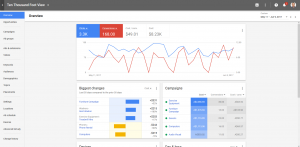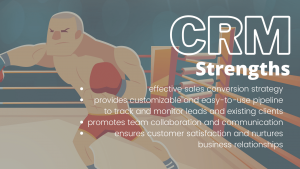— February 18, 2019

Which of the following is on your business development to-do list for 2019?
- Close more new customers
- Decrease customer churn
- Increase referrals
- All of the above
If you didn’t answer D, you’re either wildly successful (in which case, congratulations!) or you’re in trouble. But regardless of your answer, the real question is: What will it take to meet your goal?
Prospecting is hard—it takes about 18 calls to connect with a buyer. And customer retention has its own challenges, as unhappy customers are more likely to simply leave you than complain.
But never fear. This list of 2019’s top-five business development trends is a great starting point. Read on and learn how relationship intelligence technology can help you check through your to-do list fast.
1. Personalize communications
Personalization can move margins and boost business. Nearly all marketers—98 percent—agree that personalization advances client relationships. And 74 percent classify that impact as either “strong” or “extreme.”
But with personalization comes raised expectations. Today’s clients and prospects expect a tailored experience—far beyond simple data merges and persona-based communications. Indeed, 79 percent of consumers will now ignore offers that don’t meet the bar of previous interactions they’ve had with a brand. So tread carefully.
What’s more, the majority of marketers—88 percent—aren’t happy with their personalization capabilities. Their biggest pain point? Customer data collection.
To take advantage of this trend strategically, and avoid the pitfalls of data collection, take a look at relationship intelligence automation (RIA). RIA automatically keeps track of all client and prospect communications, giving you the insight you need to create high-caliber personalized communications for maximum ROI.
2. Put clients first
Back in 2013, industry experts predicted that by 2020, firms would primarily compete not on price or product quality, but on customer experience. With just a few months to go, this shift is already well underway.
By 2016, 64 percent of customers reported they’d switched providers within a year due to poor customer service. And 81 percent of them said something could have prevented the switch—but that something wasn’t done. It’s clear that in 2019, and beyond, your firm must put clients first.
But that will be hard to do if you’re unsure of where you stand with your client base. Enter: relationship analytics. Tools like Introhive use relationship analytics to automatically serve up trends (how often do you talk to your most-billed client) and activities (pending orders, support inquiries, etc.). It’ll even shoot the info right to your business development team’s inboxes before meetings.
Your team can then use that information to strategically nurture trust and loyalty, showing your clients that you value them as people—not just a line item figure.
3. Lead a digital transformation
Viva la revolution! The digital revolution, that is. But which one? This trend is so ubiquitous that every day seems to bring a new tool that’s poised to revolutionize the selling process.
Technologies like blockchain, artificial intelligence (AI), machine learning, and automation hold the power to generate more intelligence, break down silos, and streamline operations. But these endless opportunities often leave firms overwhelmed and unsure of where to start.
If you’re in business development, though, your first priority should be understanding your customer data. Here’s why: data-driven firms are killing the game. They’re 23 times more likely to acquire customers, six times more likely to retain customers, and 19 times more likely to improve ROI.
While only 37 percent of businesses believe they have successfully implemented a data-driven model, AI technology can help. With tools like Introhive, algorithms collect and aggregate wide-spread data for you, even uncovering key intel about prospective clients, industry trends, and competitive threats.
Plus, new technology can also automate mundane activities—giving you increased accuracy and better margins. Automating customer relationship management (CRM) data entry, for instance, can save each user up to 5.5 hours each week.
4. Drive business through relationships
The simple truth is that people buy from people they like. Relationship intelligence automation (RIA) is one trend that can help you make the most of this truth.
With RIA tools like Introhive, you can uncover common ground and spot relationship insights you can use to instill trust with new prospects, nurture long-standing client connections, and identify networkable prospects with the potential to lead to new opportunities.
Prospecting can be a thankless task, especially when just 1 percent of cold calls result in a meeting. Relationship mapping tools for professional service firms can save the day—or at least a few hours of it.
The tool examines the connections in your firm’s extended network and highlights the individuals who may provide a warm introduction, giving you a fast pass to a new connection. Another thing to be thankful for: customers acquired through referrals have a 37 percent higher retention rate.
5. Profit from account-based marketing
Account-based marketing (ABM) directs resources to engage a specific set of target accounts. Basically, it’s the manifestation of the first two trends on this list—personalized communication and client focus.
With a long sales cycle and numerous stakeholders to engage, ABM allows firms to nurture and engage those leads more effectively. And it works.
According to a majority of Demandbase survey respondents, ABM delivers:
- Increased target account engagement
- Better sales and marketing alignment
- More qualified prospects
- Increased understanding of program performance
- More pipeline opportunities
But if your ability to track and measure client communications is limited, this is one trend you won’t be able to take advantage of. That’s where relationship intelligence automation (RIA) comes into play. Working as an add-on to your CRM, RIA centralizes account data and breaks down information silos, so sellers have instant visibility into all the influencers in a sales cycle and who on their team has the best relationship.
With RIA sharing critical relationship insights across your entire firm, your sales and marketing teams will be much better equipped to tackle ABM.
Focus on Relationships and Technology in 2019
It’s no surprise that relationships remain at the core of business trends for 2019. This year, the challenge for firms will be to make the most of technology to advance prospective and current business.
Relationship intelligence automation is one way your firm can level-up business relationships without losing valuable time to mundane activities like data entry.
Measure relationship capital, get a 360-degree view of your firm’s overall relationship strength, and spot opportunities for referrals with relationship mapping. And use CRM data automation and automatic distribution of relationship insights to easily remain client-centric, regardless of the size of the account or the newness of the relationship.
Business & Finance Articles on Business 2 Community
(20)







